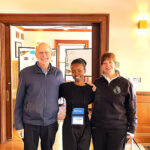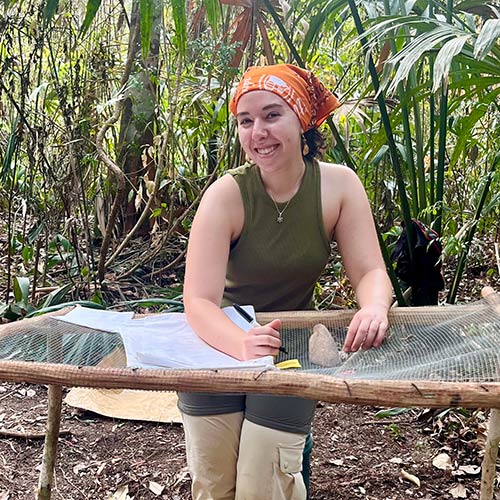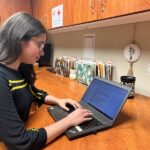
Archaeology major studies Maya artifacts in Guatemala alongside field experts

Sydney Berenson ’25, an archaeology major and Spanish & museum studies minor at The College of Wooster, was offered the opportunity to spend her summer in Guatemala participating in fieldwork and conducting ceramic analysis on ancient artifacts with Proyecto Arqueológico Waka’ (PAW) by Olivia Navarro-Farr, professor of archaeology, anthropology, and sociology at the College. Considering a career in archaeology, Berenson accepted. She took advantage of the opportunity through an APEX Fellowship.
Berenson worked alongside accomplished archaeologists during her experience. Through fieldwork at El Peru-Waka’, PAW’s archaeological site located in the Laguna del Tigre National Park within the Maya Biosphere Reserve, Berenson had the opportunity to interact with several experts, including Navarro-Farr, a co-director of PAW. At the project’s laboratory in San Lucas Sacatepéquez, Guatemala, she learned from Keith Eppich, PAW’s lead ceramic analyst and a professor in the department of anthropology at Collin College in McKinney, Texas, as well as Rene Ozaeta, PAW’s field and lab illustrator. In addition to developing her understanding of the profession through fieldwork and lab work, Berenson used the experience’s location to further refine her Spanish-speaking skills. The Archaeological Institute of America (AIA) awarded Berenson a $2,000 Jane C. Waldbaum Field School scholarship to help her finance this opportunity. The scholarship is awarded to ten students in the United States or Canada who are completing on-site, archaeological fieldwork for the first time.
“My APEX fellowship provided a well-rounded view of what is necessary to be successful in archaeology and demonstrated to me why connections are so important within this field.”
—Sydney Berenson ’25
Q: How did you learn about the internship opportunity for your APEX Fellowship?
Berenson: Olivia Navarro-Farr, one of the co-directors of Proyecto Arqueológico Waka’, offered me the opportunity.
Q: What interests you most about the work you did?
Berenson: I was really interested in the fact that the experienced touched upon pre-modern, non-western, and pre-contact archaeology with a focus on an ancestral Indigenous city in Guatemala. It not only allowed for me to continue to work on my Spanish skills, but also to learn more about ancestral Maya history. In the field I hiked to the site, I learned how to set-up and draw test pits, how to draw the periphery of archaeological monuments/architecture, and how to wash and label ceramics. My time in the jungle was both mentally and physically challenging but it was quite an adventure! In the lab I learned how to identify ceramic typologies and then sorted, counted, weighed, and recorded the data for each ceramic assemblage. Additionally, I helped to reassemble vessels and write my own section of the PAW Ceramic Informe, a government-mandated technical report that plays the role of a legal document and ensures that the project will receive a permit to continue their work.
Q: Who was your fellowship mentor and how did they help you to succeed in this position?
Berenson: Keith Eppich. He taught me how to conduct ceramic analysis, the importance of understanding the ceramic chronology at El Perú-Waka’ and would give us lessons about the history of the site and Guatemala more generally. Additionally, Rene Ozaeta served as an invaluable mentor who created a welcoming environment for students and shared meaningful insights into the culture and history of Guatemala. He also instructed us in illustrating both the peripheral and interior architecture of site structures, an opportunity that is unique for undergraduate students.
Q: What are some skills you have learned that you see yourself carrying forward in your career?
Berenson: I have learned how to be an ethically minded and advocacy-oriented archaeologist. I have also learned numerous archaeological field methods, including how to set-up and draw test pits, illustrate interior architecture, in-field lab work, and complete Munsell testing. I have also gained valuable lab skills pertaining to ceramic analysis including weighing, data management, scale drawing and how to produce scale renderings using Adobe illustrator and Adobe lightroom. Finally, my technical Spanish in archaeology has greatly improved.
Q: How has the internship helped you to see what is next for you?
Berenson: This internship provided me with the opportunity to see what working at an active archaeological project looks like in both field, laboratory, academic, and conference settings. Luckily, it only increased my desire to become an archaeologist!
Posted in Experiential Learning on August 10, 2024.
Related Posts
Related Areas of Study
Museum Studies
The Museum Studies minor requires six courses, with one required course and the remaining to be selected from experiential and theory courses. Alongside MUST […]
MinorArchaeology
Fieldwork and research are a big part of the study of prehistoric and historical archaeology
Major Minor

